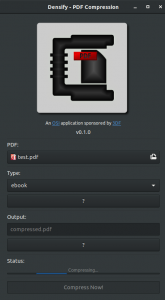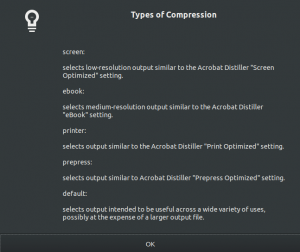A GTK+ GUI Application written in Python that simplifies compressing PDF files with Ghostscript
If you are looking for the macOS port, iDensify, please see this page instead.





Change Log
To keep up-to-date with announcements and changes, follow @3dfosi on twitter!
May 17th, 2020 – v0.3.0 Released
Features:
- Added Error Handling Unsafe Character `
- Switched to Python3 – also fixes #4
- Allow User Resize of Window
- Desktop Notification
- Handling Lower Screen Resolutions – #5
- Refined installation script (v0.2)
Bug Fixes:
- Display Icon – #3
Notes:
- Changed installation Procedure in README
MAY 13th, 2018 – v0.2.0 Released
Features:
- Improved error handling of filenames – issue #2
- Support for Chinese & other unicode file names
Bug Fixes:
- Support whitespaces in filenames – issue #1
MAY 13th, 2018 – v0.1.0 Released
- Birth of Densify
Under the Hood
It essentially takes your GUI input and turns it into the following Ghostscript command:
gs -sDEVICE=pdfwrite -dCompatibilityLevel=1.6 -dPDFSETTINGS=/ebook
-dNOPAUSE -dQUIET -dBATCH -sOutputFile=[compressed.pdf]
"[input.pdf]"
Error Handling
Currently, if any of the below conditions are met, the application will either automatically handle or show an error/warning dialog message that returns to the main window without doing anything upon the user clicking “OK”. This is designed to prevent any dangerous execution of Ghostscript. For the ones that are questionable, it will warn the user and provide a chance to cancel or confirm.
Automatically Handles:
- Output file name was not specified, use “compressed.pdf” by default
Shows an Error Dialog Message and Returns to Main Window Upon the User Clicking “OK”:
- Input file is not specified
- Input file does not end with .pdf
- Input File and Output File are the same
- Input File Name Contains Unsupported Characters(\/:;)
- Output File Name Contains Unsupported Characters(\/:;)
Questionable Conditions that the application will verify with User via A Dialog Message:
- Output File does not end with .pdf, verify with user that’s really what they want
- Output File Name Matches a File in the Output Directory
Installation
Step 1:
Download or Clone Densify
Step 2:
Execute the install.sh script from within the downloaded Densify directory to install this application:
sudo chmod a+x install.sh
sudo ./install.sh
Enter your sudo password when the dialog pops up.
You should then see this:
hkdb@machine:/opt/Densify$ sudo ./install.sh
Installation Complete. If you don't see any errors above, you are good to go! :)
hkdb@machine:/opt/Densify$
Now, you can search for “densify” in Gnome Shell Search and you will see that Densify is available to launch. Enjoy!
Future Plans
- Compile to binaries to support Linux with Nuitka
- Build Debian Packages
- Build RPM Packages
- Compile to binaries to support OS X and Windows 10
Disclaimer
This application is maintained by volunteers and in no way do the maintainers make any guarantees. Please use at your own risk!
Recognition
Many thanks to Anthony Wong and Koala Yeung for talking me through this and Dr. Haggen So for sharing the following link that inspired me to write this application:
https://www.tjansson.dk/2012/04/compressing-pdfs-using-ghostscript-under-linux/
This is an application utility sponsored by 3DF Limited’s Open Source Initiative.
Want a CLI alternative instead?
Check out cPDF, a Python script to simplify compress PDF file size with GhostScript
